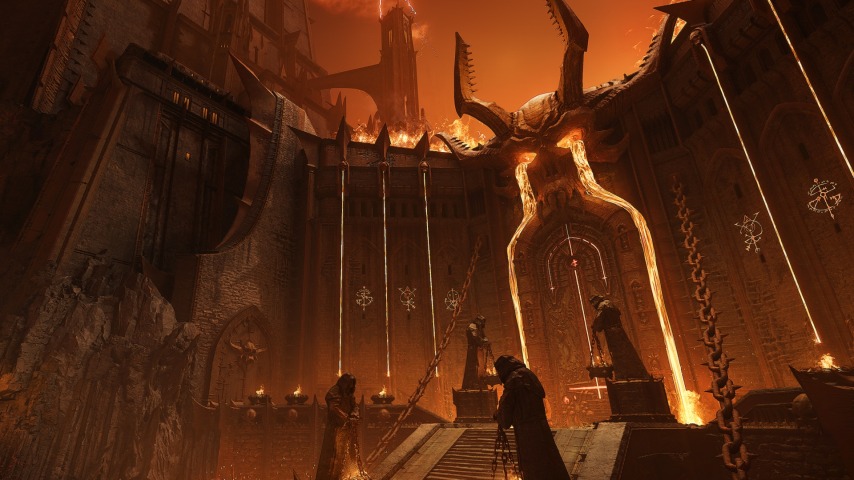Can murder be meditative?
It’s a question I ask myself courtesy of Doom: The Dark Ages, id Software’s latest violent, gore-soaked odyssey/flow state generator. The third game in the soft reboot of the classic shooter series that began with Doom (2016), Dark Ages is, on paper, a more complicated beast than either that game or its 2020 follow-up, Doom Eternal. It has more moving parts, more verbs, more systems, and, Urdak help us, more writing than the previous games, suggesting that id may have given in to the trilogy-maker’s natural urge for increased complexity at the cost of clarity.
And yet, in the hands, in the moment, in the rip-and-tear joy of actually playing the thing, it may be the purest expression of the reboot series’ highly kinetic philosophies to date. That most especially applies to the biggest addition to the taciturn, uber-violent Doom Slayer’s arsenal of killing tools, introduced early on in your roughly 15 hours of play: The Shield Saw, a rare defensive weapon for this most offense-minded of video game protagonists.
I worried, when The Dark Ages was first being previewed, that the addition of a shield would slow down the all-important velocity of Doom’s play. (Or, to crib from a far more sedate action gaming touchstone, that it might “engender passivity.”) But that was a fundamental misunderstanding of the Shield’s role in Dark Ages, which is far less about blocking damage—you can, and occasionally should, use it for that, but only in extreme circumstances—than to create new opportunities to inflict it, typically with bone-crunching impact. As players will quickly learn, the Shield is more aggressor than aegis: It allows you to dash across the landscape, smashing mooks; it allows you to hurl it, decapitating demons and breaking armor off of tougher foes; above all, it lets you parry back attacks and projectiles, painted by the game in a neon “This means ‘Go,’ motherfucker!” green, creating huge opportunities to wreak more havoc across the battlefield. Parried attacks aren’t just negated: They’re bounced back at their senders, stunning them, doing massive damage, and empowering you to push ever deeper into the fray.
(Concerned about nailing the parry timing? Great news: The Dark Ages comes with a series of beautifully customizable difficulty sliders that allow you to alter everything from how tight parry timing is, to the speed that projectiles move at, to the overall speed of the game as a whole. I played through the whole game on the default setting and had an enjoyable, if occasionally stressful, time. But the ability to match the game to your skillset is a welcome one.)
So: If the genius of Doom (2016) was in carving away everything from the core tenets of first-person shooter gameplay that was not movement and mayhem, and the central flaw of Doom Eternal was the addition of certain enemies that impeded that sense of flow by forcing you to bend to their rhythms, then The Dark Ages excels by synthesizing the more reactive elements of the latter into the aggressive glory of the former. Enemy attacks and defenses are no longer just painful interruptions of the meditative state, or goads to force you to continue to kill, as enemies pop like glorious bags of loot and health. They’re a whole new way to murder, forming another part of the semi-hypnotic, instinctively mobile game of pattern recognition that kicks in when the legions of hell spawn in, the guitars kick in on the soundtrack, and the blood fury descends.
If this key element didn’t work—if the power fantasy faltered, and the sense of being a one-man army fell apart—then nothing else in The Dark Ages would matter. As is, it’s worth taking at least a brief tour through the game’s other features, including its goofy plot (a self-serious prequel to Doom (2016)), to take in the surroundings that occupy the player’s time in the downtime between the bone-deep satisfaction of its killing sprees.
As per series standard, Doom: The Dark Ages sends you blasting through a series of landscapes that will be familiar to anyone who’s ever seen an airbrushed van, pursuing objectives and objects that are barked at you by a largely interchangeable crew of minor characters that all somehow round down to “go somewhere and kill a hundred demons.” It’s not that there aren’t clever touches—id has always been smart about giving the Slayer just enough moments of genuine, if typically furious, personality to stop him from being 100 percent a cipher. But you can never shake the sense that the ongoing machinations of various noble kings, devious hell princes, and gutless angels that make up the plot know you only half-care about them; there’s a reason that a huge percentage of this plot material gets shoved into lore notes, and more power to it. (Without spoiling anything, I will note that there was at least one late-game plot reveal that had me laughing out loud at its sheer “We’ll steal from anybody” audacity, though.)
Every few levels, the game will break up the routine by tossing you into either a giant mech suit or onto the back of a dragon, creating the rare video game moments in which getting access to colossal weapons of war makes you feel like less of a badass than more of one. Both of these digressions have their small-scale pleasures, with combat that feels even more explicitly like a rhythm game than usual. (Dragon flight also has some “chase the bad guy down” segments that are mostly there to lead you from point A to point Blow more shit up, with movement controls that are never amazing but also never a pain in the ass, which is exactly the bar they needed to clear.) But it is understood, even in the moment, that these vehicle segments are blood-soaked palate cleansers, not the main event, and the game is wise not to let any one instance of either run for too long.
Which leads us back around to the other main pillar of the Doom Reboot Game Design Handbook, and one that, pretty much by default, has to take a backseat to the pleasures of a good rampage: exploration. As with the previous games, the world of The Dark Ages is littered with secrets, codex notes, and, most tantalizingly, upgrade materials, just waiting to be poured into your latest set of sketched-in-a-high-school-metal-kid’s-math-textbook weapons. (These tend to top out at serviceable, by the way, and go heavier on cool aesthetics than mechanical innovation; yes, it’s fun that your chaingun visibly chews up skulls and fires out the fragments, but it’s still the same basic gun you’ve used in a dozen different shooters.) Finding all of this Good Stuff is aided massively by what remains one of the most generous auto-mapping systems in all of gaming, making it easy (but not too easy) to see where hidden items are lurking in the game’s sprawling maps. (One huge quality-of-life feature that every game should adopt, by the way: Clear markers showing when you’re about to pass a level’s point of no return, meaning you’ll miss any secrets you haven’t hoovered up yet.)
Which is handy, because some of those levels have become extra-sprawling, as Doom becomes the latest franchise to try to crowbar open-world gaming into an already solved gameplay system. On that score, The Dark Ages’ heavily touted “open-world” levels are smaller than many of their ilk—it helps that the Slayer moves at a lightning pace, whether you’re sprinting or not—and largely cosmetic in nature. The landscapes may be larger, but in practice, you’re still being funneled between puzzle-y bits, light elements of platforming, and the all-important arenas where major fights break out; you just have a bit more choice of what order to tackle these encounters in. The first time the game pulls this trick, in its first massive setpiece level, it’s undeniably, genuinely impressive. But as the game progresses, the open-world elements reveal themselves largely as window-dressing, just another way to break up the necessary moments that allow the pulse to slow back down in between fights.
And, really, it all loops back to there. In my time with Doom: The Dark Ages, I was sometimes engaged with its other systems—deciding which upgrades to buy for my guns, poking at a secret to try to figure out how to crack my way into it, even, in moments of idle curiosity, reading some of those copious lore notes. But it was all prelude to the main event. And that main event is as good as it’s ever been: A brightly colored, sanguine distillation of everything that’s good about twitch shooter gaming. The Dark Ages nails it; everything else flows from that ferocious bleeding heart.
Developer: id Software
Publisher: Bethesda Softworks
Platforms: PlayStation 5, Xbox Series X/S, Windows
Reviewed on: PlayStation 5
Price: $70








































